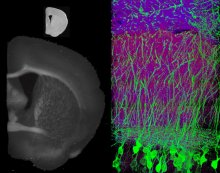 February 10, 2015 - 4:00 pm to 5:30 pm
February 10, 2015 - 4:00 pm to 5:30 pm Ed Boyden, CBMM Thrust 2: Circuits for Intelligence
*Talk was rescheduled to March 10th*
Topic: Progress on the CBMM challenge questions: What is there? What’s happening now? And why?
Abstract:
Ideally we would have maps of the molecular and anatomical circuitry of the brain, as well as of the dynamic activity of the brain, with sufficient detail to reveal how brain circuits generate the computations that support intelligent behavior. Our group is working
on three new approaches to address this need.
First, we have developed a fundamentally new super-resolution light microscopy technology that is faster than any other super-resolution
technology, on a per-voxel basis. We anticipate that our new microscopy method, and improved versions we are working on currently, will enable imaging of molecular and anatomical information throughout entire brain circuits, and perhaps even entire brains.
Second, we have adopted to neuroscience the technology of plenoptic or lightfield microscopy, a technology that enables single-shot 3-D
images to be acquired without moving parts, and thus can be used to record high-speed movies of neural activity (Nature Methods
11:727-730). We are continuing to improve such microscopes, to the point where they may be useful for imaging the entire mammalian
cortex.
Finally, we are working to get the world’s smallest mammal, the Etruscan shrew, going as a model system in visual neuroscience. The
Etruscan shrew has a small brain, with a six-layer cortex just a few hundred microns thick, and a visual cortex with perhaps just 75,000 neurons — less than the larval zebrafish. It is small enough that entire molecular and anatomical maps, as well as dynamic activity maps, of the visual cortex might be feasible using the above tools, in the near future. We will seek to answer the CBMM challenge questions in the context of the Etruscan shrew visual system.
Details
52 Oxford Street, Harvard University Northwest Building, Cambridge, 02138
